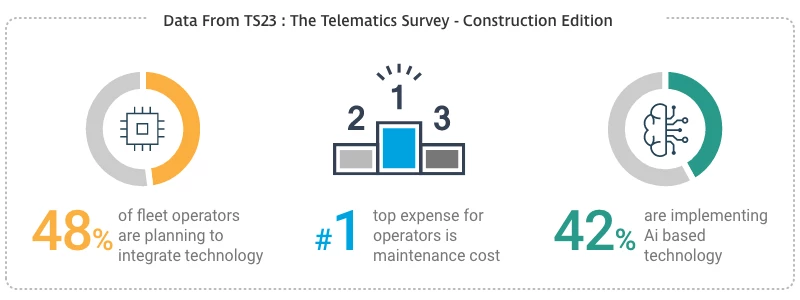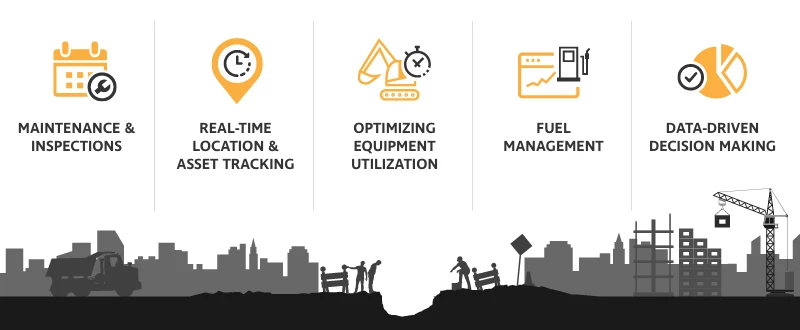Key Takeaways
As the construction industry evolves, efficiently managing a mixed fleet of vehicles and equipment has never been more important. This guide explores how digital transformation can provide comprehensive solutions to complex challenges, specifically focusing on mixed fleet management and equipment management through platforms like TN360 ACM. Here's what you need to know to keep your fleet ahead of the curve.
Table of Contents
- Why Digital Transformation is Essential for Effective Construction Fleet Management
- 5 Ways Telematics can Help Construction Fleets Digitally Transform
- The Power of Software Integration
- Find Advanced Digital Fleet Management Solutions with TN360 ACM
Why Digital Transformation is Essential for Effective Construction Fleet Management
The construction industry is no stranger to challenges, but arguably, one of the most substantial changes in recent years is the shift from manual, paper-based processes to digital solutions. While many businesses remain reliant on the former, the latter eliminates the use of paper, minimises labour-intensive procedures and enables real-time, data-driven decision-making.
According to the TS23 Telematics Survey, over the next year, nearly half of all companies plan to integrate technologies across their fleet. This shift to digitise and streamline processes represents a strategic shift towards better efficiency, cost savings, and improved sustainability for business operations. With construction fleet operators battling high maintenance costs, rising fuel spend and project delays, the move to more efficient processes has never been more important.

Navigating the Complexities of Mixed Fleet Management
Managing a construction fleet is more complex than handling a uniform set of vehicles. Often, these fleets are a mix of light-duty vehicles, heavy-duty machinery, and other specialised equipment. However, embracing digital solutions like construction fleet management software can centralise visibility into your operation, giving you the tools to manage all of your on-road vehicles, heavy-duty equipment and other assets in one platform. Having all of your fleet information in one location simplifies daily processes such as pre-trip inspections, provides the visibility to increase utilisation and simplifies performance analysis.
The Importance of Effective Maintenance Planning
Vehicle and equipment maintenance was identified as a major expense across construction fleets, with 44% of operators saying it was one of their largest costs. This has only been made more challenging with supply chain pressure limiting parts availability and increasing downtime. With the true cost of maintenance being impacted by parts, labour and rental costs, having effective preventative maintenance schedules is becoming increasingly important. This is where computerised maintenance management can help, by automatically triggering maintenance events off odometer readings, engine hours or inspection data, maintenance teams can effectively plan maintenance schedules, forecast parts inventory and minimise unscheduled downtime.
Improving Operations Through Digital Transformation
In the construction industry, controlling costs, enhancing customer service, and maintaining competitiveness are paramount. Digital transformation directly addresses these areas by optimising operations. According to the TS23 Construction Telematics Survey, businesses focusing on the use of telematics have reported improvements in on-time and on-budget project delivery, resulting in more satisfied customers. Additionally, 97% of telematics users report a reduction in fuel costs of up to 40% after implementation. By improving business processes and controlling costs, construction operations can manage their diverse fleets more effectively and achieve greater operational efficiency and cost-effectiveness.
5 Ways Telematics can Help Construction Fleets Digitally Transform
Digital transformation is a journey that starts by understanding the key areas of your business where digital transformation can have the most impact. These are usually areas where existing processes are time consuming, lead to poor information capture or where costs are increasing. Across the construction fleets we support the five most common areas of focus are:
Maintenance and Inspections
In the digitally transformed landscape of construction fleet management, the process of maintenance and inspections has become significantly more streamlined and efficient. With the integration of digital inspection tools, locating equipment for inspections is no longer a time-consuming task. The ease of conducting these inspections digitally means that any issues identified can be immediately recorded and processed. This seamless transition from inspection to action is also crucial to ensure that vehicles and equipment are safe to operate and that small issues don’t turn into lengthy downtime.
Real-Time Location and Asset Tracking
In an industry where time is money, knowing the exact location of every asset in real time is invaluable. Advanced GPS-based systems provide fleet managers with immediate insights into their equipment and vehicles' location and movement patterns, enhancing scheduling and project management. Additionally, by safeguarding against theft and unauthorised use, these systems can save companies significant financial losses and expedite recovery processes when incidents occur.

Optimising Equipment Utilisation
Optimising job dispatch and equipment utilisation is necessary for maximum productivity and cost efficiency. With construction fleet management software, real-time data on equipment location and status becomes accessible, allowing fleet managers to allocate resources where they are most needed. This immediate accessibility ensures that equipment isn't left unused when it could be contributing to a project somewhere else. By analysing usage patterns and job demands, companies can also forecast equipment needs for future projects, preventing resource overlaps or shortages. This precision allocation and forecasting can streamline operations and lead to additional cost savings.
Fuel Management
Efficient fuel management is a cornerstone of effective fleet management, especially in the construction sector where heavy-duty vehicles and machinery are prevalent. In addition to monitoring fuel consumption patterns for cost savings and environmental impact, it's also important to consider engine idling. Excessive idling wastes fuel and contributes to increased wear and tear on equipment. By leveraging construction fleet management software, companies can gain insights into idling patterns and identify areas where improvements can be made. Addressing engine idling can lead to significant reductions in fuel costs and help in maintaining equipment health. Real-time data provided by these digital solutions enables companies to make informed decisions, optimising routes for fuel conservation and identifying potential issues like fuel theft or inefficient usage.
Data-Driven Decision Making
In the digital transformation era, data-driven decision-making is one of the most tangible benefits for construction fleet managers. Harnessing real-time data collected from various assets enables stakeholders to assess performance trends, pinpoint inefficiencies, and predict potential challenges. Platforms like TN360 ACM consolidate this data, presenting it in an easily digestible format, allowing for swift and informed responses. As a result, managers can optimise operations, allocate resources more effectively, and proactively address issues, all culminating in enhancing the overall efficiency and profitability of construction projects.
The Power of Software Integration
In an interconnected digital ecosystem, the seamless integration of construction fleet management software with other enterprise systems becomes paramount. Software integration allows construction companies to create a harmonious data flow by linking their fleet management platforms with third-party applications, ERP systems, payroll solutions, and more. This cohesive environment streamlines operations and eliminates data silos, ensuring crucial insights are available across various departments. As construction projects become increasingly complex, an integrated system provides timely and efficient communication, accelerating decision-making and enhancing overall project efficiency.
Find Advanced Digital Fleet Management Solutions with TN360 ACM
Digitisation has become necessary for construction companies aiming for efficiency, sustainability, and a competitive edge. From preventative maintenance to real-time asset tracking and data-driven decision-making, digital transformation offers many benefits.
If you're looking for a one-stop solution for your mixed fleet and construction equipment management needs, Teletrac Navman's customisable TN360 ACM platform stands above the rest. Designed to provide complete visibility into how on-road vehicles, heavy equipment, and non-powered assets are maintained and utilised across job sites.
Contact our team today to see how TN360 can revolutionise your digital transformation. You can also price your platform configuration using our online tool.

